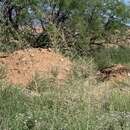More info for the terms:
cover,
fire severity,
fuel,
grassland,
headfire,
severity,
top-kill,
wildfireBig sacaton sprouts after top-kill by fire [
53]. Big sacaton may
recover to prefire coverage in 2 to 3 years on ungrazed sites [
4].
Postfire recovery is influenced by fire severity [
2] and season of
burning [
14]. In southeastern Arizona in 1975 and 1976 three wildfires
occurred in an ungrazed big sacaton grassland community [
2]. The first
two fires occurred in mid-May and mid-June 1975, and the third in
February 1976. Permanent study sites were established on the two summer
burns and on adjacent unburned (control) areas in August 1975. In
February 1976 a wildfire occurred on one of the control sites which then
became the winter burn study site. The summer burns occurred during
hot, dry weather and were probably more severe than the winter burn [
2].
Big sacaton postfire percent cover on the four study sites is listed
below; prefire cover was not reported.
summer burns winter burn
control first year second year first year
sacaton 74 35 70 50
In postfire year 1, big sacaton percent cover was less on burned than
unburned sites, and less on the summer than winter burns. It was
similar to prefire cover in the second year [
2].
In southeastern Arizona the impacts of burning on big sacaton forage
quality and quantity were studied [
14,
15]. Plots were burned with a
headfire in winter (Feb. 6), summer (July 10), and fall (Oct. 2) 1980,
1981, and 1982. Plots had been lightly grazed for 5 years prior to
burning. The time from ignition to total forage consumption by fire was
recorded by plot. Fuel moistures and weather conditions were as follows
[
14]:
fine fuel-moisture wind speed air temperature
% oven-dry weight mi/hr (km/hr) deg F (deg C)
winter 10-30 10 (16) 50-64 (10-18)
summer 20-25 8-15 (13-24) 84-86 (29-30)
fall 45-55 8-10 (13-16) 66-77 (19-25)
Big sacaton green forage at the peak of the summer growing season (Aug.
21) 1,2, and 3 years after treatment was as follows:
number of growing seasons after treatment
1 2 3
kg/ha
winter 400-735 690-850 595-695
summer 700-865 850-935 1,375-1,590
fall 260-725 575-805 745-890
untreated 1,695-1,900 1,365-1,720 1,650-2,000
Green forage availability for the 3 treatment years was consistently
greater on untreated plots than on burned plots. In postfire years 1
and 2, big sacaton green forage was greater on summer than on winter- or
fall-burned plots. By postfire year 3 green forage on summer-burned
plots was nearly equivalent to that on unburned plots [
14]. At postfire
year 1, standing crops were 60 percent less on spring- and fall-burned
plots. At postfire year 2, live biomass on spring-burned plots was 30
percent less than on control plots. On fall-burned plots, 50 percent of
plants failed to produce leaves the following spring. Removing hte
standing dead biomass which insulates against cold temperatures may have
killed the plants [
56].

